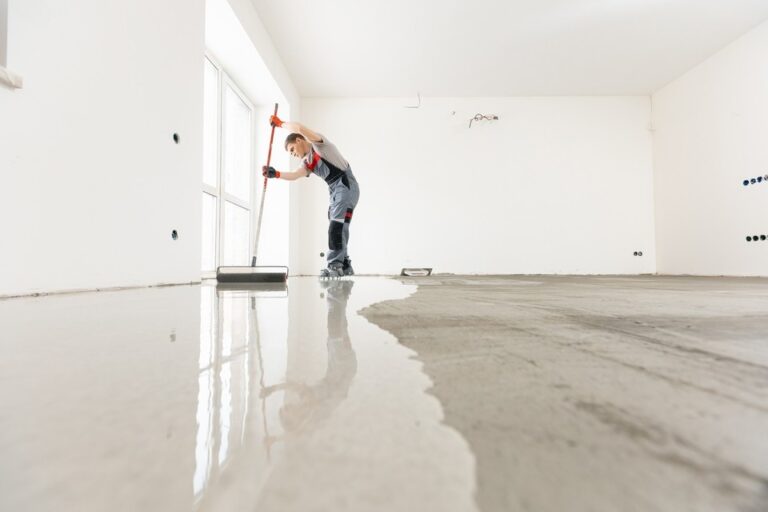Concrete floors hold secret potential most folks never notice.
What looks like plain gray slabs can transform into stunning surfaces full of depth and personality.
The raw, industrial feel works in almost any home, from sleek modern spaces to rustic farmhouses. Plus, concrete floors last practically forever when treated right.
Many homeowners don’t realize the concrete sitting under their old carpet or laminate could become their favorite feature with a little know-how.
Unlike engineered hardwood or expensive tile, concrete already exists in most homes as the subfloor or foundation.
This means you’re working with what you’ve got, not tearing everything out to start fresh.
Ready to fall in love with concrete floors? These ten approaches will help you bring out their natural character while creating a look that fits your style.
How To Bring Character Back To Concrete Floors
Getting your concrete floors to shine takes some work, but the results can amaze you.
The beauty of concrete is how versatile it becomes with different treatments.
You can go glossy and sleek or rustic and textured. The same basic material adapts to whatever look matches your home.
Before jumping in, check your concrete’s condition.
Some floors need basic cleaning while others require serious repairs. The good news? Almost any concrete floor can transform with the right approach.
From simple staining to fancy epoxy finishes, you’ll find options for every budget and skill level.
Let’s walk through ten ways to wake up those sleeping concrete floors.
Deep Clean to Reveal Natural Beauty
Most concrete floors hide under years of dirt, paint splatters, and mystery stains.
A deep clean might be all you need to discover what’s really there.
Start with a push broom to remove loose debris, then tackle the tough stuff.
Concrete cleaning requires muscle.
Rent a floor buffer with scrubbing attachments from your local hardware store.
Try a degreaser for oil spots and a concrete cleaner for general grime.
The cleaning process strips away years of buildup, often revealing cool natural patterns and color variations.
Watch for surprises during cleaning.
Some floors show aggregate (those little stones mixed in the concrete) or interesting color shifts nobody knew existed.
Take your time with stubborn stains.
Sometimes what looks like damage turns out to be character once properly cleaned.
Repair Cracks and Surface Imperfections
Every crack tells a story, but some stories need editing.
Small hairline cracks add character, while bigger gaps need fixing before you move forward with any decorative treatments.
Concrete patching compounds work wonders for repairs.
Mix according to package directions and press firmly into cracks with a putty knife.
For wider cracks, you might need a two-part epoxy filler that bonds more strongly. Let everything cure fully before sanding smooth.
Some folks choose to highlight rather than hide certain cracks, filling them with contrasting colored epoxy that makes them stand out like rivers running through the floor.
This Japanese-inspired technique called “kintsugi” celebrates the beauty of imperfection rather than hiding it.
Apply a Stylish Concrete Stain
Staining concrete ranks as one of the most dramatic transformations you can make.
Unlike paint that sits on top, stains react chemically with the concrete, creating variations that look totally natural.
Two main types exist: acid stains and water-based stains.
Acid stains create marbled, variegated effects in earth tones like amber, brown, blue-green, and copper.
Water-based stains offer more color options but less natural variation.
Before staining, test in a hidden spot. Every concrete floor reacts differently based on its age and composition.
For those considering a DIY approach, resources like concrete staining guides offer step-by-step instructions.
Apply with sprayers, brushes, or sponges depending on the look you want.
The key is working in sections and blending as you go to avoid obvious stop lines.
Try Polishing for a High-End Look
Polished concrete gives you that sleek, almost wet-look shine without the slipperiness of wax.
The process involves grinding the surface with progressively finer diamond pads until it shines like glass.
Professional polishing equipment makes this job easier, but determined DIYers can rent what they need.
Start with coarse grinding to remove any surface imperfections, then work through medium and fine grits. Between grinds, apply a densifier that hardens the concrete for better polishing results.
The magic happens in the final passes.
Your dull gray floor transforms into a gleaming surface that reflects light beautifully.
The best part? Polished concrete needs very little maintenance compared to other flooring options.
Just dust mop regularly and occasionally damp mop with plain water or pH-neutral cleaner.
Add Texture with Decorative Overlays
When your concrete looks too damaged for simple treatments, overlays save the day.
These thin layers of polymer-modified cement apply over existing concrete, creating a fresh canvas.
Overlays come in various thicknesses.
Micro-toppings spread paper-thin for a smooth finish, while stampable overlays apply thicker so you can press patterns into them.
Popular patterns mimic slate, tile, cobblestone, or even wood planks.
The application process starts with thorough surface prep.
Every speck of dirt or loose concrete must go before spreading the overlay material.
Work quickly as these materials set fast.
After curing, you can color with stains or dyes just like regular concrete.
The result? A completely transformed floor without the hassle and expense of removal and replacement.
Bring Warmth with Area Rugs
Concrete floors look amazing but sometimes feel cold underfoot.
Strategic rug placement solves this problem while adding color, texture, and sound absorption.
Choose rugs that complement your concrete.
Natural fiber rugs like jute or sisal enhance industrial spaces with organic texture.
For colorful concrete, neutral rugs balance the look.
Bold patterned rugs work wonderfully with simple gray concrete.
Pay attention to rug placement.
Define conversation areas in living rooms, add comfort under dining tables, and create cozy landing spots beside beds.
Use rug pads with rubber backing to prevent slipping on smooth concrete.
Rotate rugs occasionally since concrete doesn’t fade like rugs do when exposed to sunlight.
Incorporate Painted Patterns or Borders
Paint offers endless possibilities for concrete floors.
Unlike stain, paint creates precise patterns, bold colors, and clear borders that transform ordinary floors into custom works of art.
Start with concrete floor paint specifically made for high-traffic areas.
Regular wall paint won’t hold up to foot traffic.
Create simple stripes by taping off sections, or go wild with stencils for intricate patterns.
Checkerboards look particularly striking on concrete and only require careful measuring and masking tape.
Consider painting just a border around the room perimeter or creating a “rug” effect in the center of a space.
This partial approach highlights the natural concrete while adding personality through color.
Be sure to seal painted concrete with a clear topcoat made for floors to protect your artwork from scratches and wear.
Install In-Floor Heating
Cold concrete ranks as the biggest complaint from homeowners.
Under-floor heating systems solve this problem permanently while remaining completely hidden from view.
Two main options exist: electric mat systems and hydronic (water-based) systems.
Electric mats install more easily for DIYers, while hydronic systems cost less to operate long-term. Both work wonderfully under concrete.
For existing floors, consider a retrofit where you pour a thin layer of self-leveling concrete over the heating elements.
New construction allows heating elements to be placed before the concrete pour. Either way, the result feels heavenly on winter mornings.
Program your system with a smart thermostat to warm floors just before wake-up time for the ultimate comfort upgrade.
Use Epoxy for Modern Gloss and Protection
Epoxy flooring creates that ultra-smooth, high-gloss finish you’ve seen in showrooms and high-end garages.
Beyond looks, epoxy forms a tough shell that resists stains, chemicals, and heavy traffic.
The application involves mixing two components that chemically react to form a hard plastic coating.
Before applying, make sure your concrete passes the moisture test – tape down a small piece of plastic for 24 hours to check for condensation, which signals moisture problems that will ruin epoxy.
Get creative with epoxy by adding color flakes between coats for a terrazzo-like appearance.
Metallic epoxy systems contain reflective pigments that create swirling, three-dimensional effects resembling marble or flowing water.
While application takes practice, the results look absolutely stunning and clean up with just a damp mop.
Seal and Maintain for Long-Lasting Character
Even the most beautiful concrete floor fails without proper sealing and maintenance. Sealing blocks stains, resists moisture, and enhances colors while providing a protective wear layer.
Choose sealers based on your concrete’s location and treatment.
Acrylic sealers work well for interior stained concrete, while polyurethane offers better protection for high-traffic areas.
Penetrating sealers soak in without changing the surface appearance, making them perfect for exterior concrete.
Apply sealer with a pump sprayer or microfiber mop in thin, even coats.
Two thin coats protect better than one thick coat that might turn cloudy.
Plan on resealing every 2-5 years depending on traffic and wear.
Between sealing, clean with mild soap and water, avoiding harsh chemicals that can damage the sealer and expose your concrete to stains.
Conclusion
Concrete floors don’t deserve their boring reputation.
With these ten approaches, you can transform utilitarian gray slabs into stunning surfaces full of depth and character.
The best part? Concrete outlasts most other right flooring options when properly finished and maintained.
Start by understanding what you’ve got.
Clean thoroughly to reveal your concrete’s true nature, then choose treatments that match both your style and your concrete’s condition.
Whether you prefer the glossy perfection of polished concrete or the artistic possibilities of stains and overlays, your options stretch as far as your imagination.
Your concrete floors hold hidden potential.
With some attention and creativity, they’ll become your home’s most striking feature rather than something to hide under carpet or vinyl.
Your floors have been waiting all this time to show their true character.
Now you know exactly how to bring it out.



